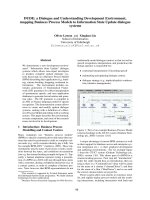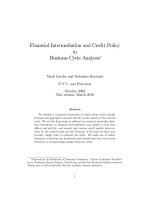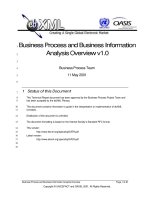Business process improvement_7 pot
Bạn đang xem bản rút gọn của tài liệu. Xem và tải ngay bản đầy đủ của tài liệu tại đây (1.85 MB, 29 trang )
Model appears
to account for
most of the
variability
At this stage, this model appears to account for most of the variability in the response, achieving
an adjusted R
2
of 0.982. All the main effects are significant, as are 6 2-factor interactions and 1
3-factor interaction. The only interaction that makes little physical sense is the " X4:
Direction*X5: Batch" interaction - why would the response using one batch of material react
differently when the batch is cut in a different direction as compared to another batch of the same
formulation?
However, before accepting any model, residuals need to be examined.
Step 4: Test the model assumptions using residual graphs (adjust and simplify as needed)
Plot of
residuals
versus
predicted
responses
First we look at the residuals plotted versus the predicted responses.
The residuals appear to spread out more with larger values of predicted strength, which should
not happen when there is a common variance.
Next we examine the normality of the residuals with a normal quantile plot, a box plot and a
histogram.
5.4.7.1. Full factorial example
(9 of 15) [5/1/2006 10:30:49 AM]
None of these plots appear to show typical normal residuals and 4 of the 32 data points appear as
outliers in the box plot.
Step 4 continued: Transform the data and fit the model again
Box-Cox
Transformation
We next look at whether we can model a transformation of the response variable and obtain
residuals with the assumed properties. JMP calculates an optimum Box-Cox transformation by
finding the value of
that minimizes the model SSE. Note: the Box-Cox transformation used in
JMP is different from the transformation used in Dataplot, but roughly equivalent.
Box-Cox Transformation Graph
The optimum is found at = 0.2. A new column Y: Strength X is calculated and added to the
JMP data spreadsheet. The properties of this column, showing the transformation equation, are
shown below.
5.4.7.1. Full factorial example
(10 of 15) [5/1/2006 10:30:49 AM]
JMP data
transformation
menu
Data Transformation Column Properties
Fit model to
transformed
data
When the 12-effect model is fit to the transformed data, the "X4: Direction*X5: Batch"
interaction term is no longer significant. The 11-effect model fit is shown below, with parameter
estimates and p-values.
JMP output for
fitted model
after applying
Box-Cox
transformation
Output after Fitting the 11-Effect Model to
Tranformed Response Data
Response: Y: Strength X
Summary of Fit
RSquare 0.99041
RSquare Adj 0.985135
Root Mean Square Error 13.81065
Mean of Response 1917.115
Observations (or Sum Wgts) 32
Parameter
Effect Estimate p-value
Intercept 1917.115 <.0001
X1: Table Speed 5.777 0.0282
X2: Feed Rate 11.691 0.0001
X1: Table Speed* -14.467 <.0001
X2: Feed Rate
X3: Wheel Grit -21.649 <.0001
X1: Table Speed* 7.339 0.007
X3: Wheel Grit
X4: Direction -99.272 <.0001
X1: Table Speed* -7.188 0.0080
X4: Direction
X2: Feed Rate* -9.160 0.0013
X4: Direction
5.4.7.1. Full factorial example
(11 of 15) [5/1/2006 10:30:49 AM]
X1: Table Speed* 15.325 <.0001
X2: Feed Rate*
X4:Direction
X3: Wheel Grit* 12.965 <.0001
X4: Direction
X5: Batch -31.871 <.0001
Model has high
R
2
This model has a very high R
2
and adjusted R
2
. The residual plots (shown below) are quite a bit
better behaved than before, and pass the Wilk-Shapiro test for normality.
Residual plots
from model
with
transformed
response
The run sequence plot of the residuals does not indicate any time dependent patterns.
5.4.7.1. Full factorial example
(12 of 15) [5/1/2006 10:30:49 AM]
The normal probability plot, box plot, and the histogram of the residuals do not indicate any
serious violations of the model assumptions.
Step 5. Answer the questions in your experimental objectives
Important main
effects and
interaction
effects
The magnitudes of the effect estimates show that "Direction" is by far the most important factor.
"Batch" plays the next most critical role, followed by "Wheel Grit". Then, there are several
important interactions followed by "Feed Rate". "Table Speed" plays a role in almost every
significant interaction term, but is the least important main effect on its own. Note that large
interactions can obscure main effects.
Plots of the
main effects
and significant
2-way
interactions
Plots of the main effects and the significant 2-way interactions are shown below.
5.4.7.1. Full factorial example
(13 of 15) [5/1/2006 10:30:49 AM]
Prediction
profile
To determine the best setting to use for maximum ceramic strength, JMP has the "Prediction
Profile" option shown below.
Y: Strength X
Prediction Profile
The vertical lines indicate the optimal factor settings to maximize the (transformed) strength
response. Translating from -1 and +1 back to the actual factor settings, we have: Table speed at
"1" or .125m/s; Down Feed Rate at "1" or .125 mm; Wheel Grit at "-1" or 140/170 and Direction
at "-1" or longitudinal.
Unfortunately, "Batch" is also a very significant factor, with the first batch giving higher
strengths than the second. Unless it is possible to learn what worked well with this batch, and
how to repeat it, not much can be done about this factor.
Comments
5.4.7.1. Full factorial example
(14 of 15) [5/1/2006 10:30:49 AM]
Analyses with
value of
Direction fixed
indicates
complex model
is needed only
for transverse
cut
One might ask what an analysis of just the 2
4
factorial with "Direction" kept at -1 (i.e.,
longitudinal) would yield. This analysis turns out to have a very simple model; only
"Wheel Grit" and "Batch" are significant main effects and no interactions are significant.
If, on the other hand, we do an analysis of the 2
4
factorial with "Direction" kept at +1 (i.e.,
transverse), then we obtain a 7-parameter model with all the main effects and interactions
we saw in the 2
5
analysis, except, of course, any terms involving "Direction".
So it appears that the complex model of the full analysis came from the physical properties
of a transverse cut, and these complexities are not present for longitudinal cuts.
1.
Half fraction
design
If we had assumed that three-factor and higher interactions were negligible before
experimenting, a
half fraction design might have been chosen. In hindsight, we would
have obtained valid estimates for all main effects and two-factor interactions except for X3
and X5, which would have been aliased with X1*X2*X4 in that half fraction.
2.
Natural log
transformation
Finally, we note that many analysts might prefer to adopt a natural logarithm
transformation (i.e., use ln Y) as the response instead of using a Box-Cox transformation
with an exponent of 0.2. The natural logarithm transformation corresponds to an exponent
of
= 0 in the Box-Cox graph.
3.
5.4.7.1. Full factorial example
(15 of 15) [5/1/2006 10:30:49 AM]
5. Process Improvement
5.4. Analysis of DOE data
5.4.7. Examples of DOE's
5.4.7.2.Fractional factorial example
A "Catapult" Fractional Factorial Experiment
A step-by-step
analysis of a
fractional
factorial
"catapult"
experiment
This experiment was conducted by a team of students on a catapult – a table-top wooden device
used to teach design of experiments and statistical process control. The catapult has several
controllable factors and a response easily measured in a classroom setting. It has been used for
over 10 years in hundreds of classes. Below is a small picture of a catapult that can be opened to
view a larger version.
Catapult
Description of Experiment: Response and Factors
The experiment
has five factors
that might
affect the
distance the
golf ball
travels
Purpose: To determine the significant factors that affect the distance the ball is thrown by the
catapult, and to determine the settings required to reach 3 different distances (30, 60 and 90
inches).
Response Variable: The distance in inches from the front of the catapult to the spot where the ball
lands. The ball is a plastic golf ball.
Number of observations: 20 (a 2
5-1
resolution V design with 4 center points).
Variables:
Response Variable Y = distance1.
Factor 1 = band height (height of the pivot point for the rubber bands – levels were 2.25
and 4.75 inches with a centerpoint level of 3.5)
2.
Factor 2 = start angle (location of the arm when the operator releases– starts the forward
motion of the arm – levels were 0 and 20 degrees with a centerpoint level of 10 degrees)
3.
Factor 3 = rubber bands (number of rubber bands used on the catapult– levels were 1 and 2
bands)
4.
Factor 4 = arm length (distance the arm is extended – levels were 0 and 4 inches with a
centerpoint level of 2 inches)
5.
Factor 5 = stop angle (location of the arm where the forward motion of the arm is stopped
and the ball starts flying – levels were 45 and 80 degrees with a centerpoint level of 62
degrees)
6.
5.4.7.2. Fractional factorial example
(1 of 18) [5/1/2006 10:30:51 AM]
Design matrix
and responses
(in run order)
The design matrix appears below in (randomized) run order.
You can
download the
data in a
spreadsheet
Readers who want to analyze this experiment may download an Excel spreadsheet catapult.xls or
a JMP spreadsheet capapult.jmp.
One discrete
factor
Note that 4 of the factors are continuous, and one – number of rubber bands – is discrete. Due to
the presence of this discrete factor, we actually have two different centerpoints, each with two
runs. Runs 7 and 19 are with one rubber band, and the center of the other factors, while runs 2
and 13 are with two rubber bands and the center of the other factors.
5 confirmatory
runs
After analyzing the 20 runs and determining factor settings needed to achieve predicted distances
of 30, 60 and 90 inches, the team was asked to conduct 5 confirmatory runs at each of the derived
settings.
Analysis of the Experiment
Analyze with
JMP software
The experimental data will be analyzed using SAS JMP 3.2.6 software.
Step 1: Look at the data
5.4.7.2. Fractional factorial example
(2 of 18) [5/1/2006 10:30:51 AM]
Histogram, box
plot, and
normal
probability
plot of the
response
We start by plotting the data several ways to see if any trends or anomalies appear that would not
be accounted for by the models.
The distribution of the response is given below:
We can see the large spread of the data and a pattern to the data that should be explained by the
analysis.
Plot of
response
versus run
order
Next we look at the responses versus the run order to see if there might be a time sequence
component. The four highlighted points are the center points in the design. Recall that runs 2 and
13 had 2 rubber bands and runs 7 and 19 had 1 rubber band. There may be a slight aging of the
rubber bands in that the second center point resulted in a distance that was a little shorter than the
first for each pair.
5.4.7.2. Fractional factorial example
(3 of 18) [5/1/2006 10:30:51 AM]
Plots of
responses
versus factor
columns
Next look at the plots of responses sorted by factor columns.
5.4.7.2. Fractional factorial example
(4 of 18) [5/1/2006 10:30:51 AM]
5.4.7.2. Fractional factorial example
(5 of 18) [5/1/2006 10:30:51 AM]
Several factors appear to change the average response level and most have a large spread at each
of the levels.
Step 2: Create the theoretical model
The resolution
V design can
estimate main
effects and all
2-factor
interactions
With a resolution V design we are able to estimate all the main effects and all two-factor
interactions cleanly – without worrying about confounding. Therefore, the initial model will have
16 terms – the intercept term, the 5 main effects, and the 10 two-factor interactions.
Step 3: Create the actual model from the data
Variable
coding
Note we have used the orthogonally coded columns for the analysis, and have abbreviated the
factor names as follows:
Bheight = band height
Start = start angle
Bands = number of rubber bands
Stop = stop angle
Arm = arm length.
JMP output
after fitting the
trial model (all
main factors
and 2-factor
interactions)
The following is the JMP output after fitting the trial model (all main factors and 2-factor
interactions).
5.4.7.2. Fractional factorial example
(6 of 18) [5/1/2006 10:30:51 AM]
Use p-values to
help select
significant
effects, and
also use a
normal plot
The model has a good R
2
value, but the fact that R
2
adjusted is considerably smaller indicates that
we undoubtedly have some terms in our model that are not significant. Scanning the column of
p-values (labeled Prob>|t| in the JMP output) for small values shows 5 significant effects at the
0.05 level and another one at the 0.10 level.
The normal plot of effects is a useful graphical tool to determine significant effects. The graph
below shows that there are 9 terms in the model that can be assumed to be noise. That would
leave 6 terms to be included in the model. Whereas the output above shows a p-value of 0.0836
for the interaction of bands and arm, the normal plot suggests we treat this interaction as
significant.
5.4.7.2. Fractional factorial example
(7 of 18) [5/1/2006 10:30:51 AM]
A refit using
just the effects
that appear to
matter
Remove the non-significant terms from the model and refit to produce the following output:
R
2
is OK and
there is no
significant
model "lack of
fit"
The R
2
and R
2
adjusted values are acceptable. The ANOVA table shows us that the model is
significant, and the Lack of Fit table shows that there is no significant lack of fit.
The Parameter estimates table is below.
Step 4: Test the model assumptions using residual graphs (adjust and simplify as needed)
5.4.7.2. Fractional factorial example
(8 of 18) [5/1/2006 10:30:51 AM]
Histogram of
the residuals to
test the model
assumptions
We should test that the residuals are approximately normally distributed, are independent, and
have equal variances. First we create a histogram of the residual values.
The residuals do appear to have, at least approximately, a normal distributed.
Plot of
residuals
versus
predicted
values
Next we plot the residuals versus the predicted values.
There does not appear to be a pattern to the residuals. One observation about the graph, from a
single point, is that the model performs poorly in predicting a short distance. In fact, run number
10 had a measured distance of 8 inches, but the model predicts -11 inches, giving a residual of 19.
The fact that the model predicts an impossible negative distance is an obvious shortcoming of the
model. We may not be successful at predicting the catapult settings required to hit a distance less
5.4.7.2. Fractional factorial example
(9 of 18) [5/1/2006 10:30:51 AM]
than 25 inches. This is not surprising since there is only one data value less than 28 inches. Recall
that the objective is for distances of 30, 60, and 90 inches.
Plot of
residuals
versus run
order
Next we plot the residual values versus the run order of the design. The highlighted points are the
centerpoint values. Recall that run numbers 2 and 13 had two rubber bands while run numbers 7
and 19 had only one rubber band.
Plots of
residuals
versus the
factor
variables
Next we look at the residual values versus each of the factors.
5.4.7.2. Fractional factorial example
(10 of 18) [5/1/2006 10:30:51 AM]
The residual
graphs are not
ideal, although
the model
passes "lack of
fit"
quantitative
tests
Most of the residual graphs versus the factors appear to have a slight "frown" on the graph (higher
residuals in the center). This may indicate a lack of fit, or sign of curvature at the centerpoint
values. The Lack of Fit table, however, indicates that the lack of fit is not significant.
5.4.7.2. Fractional factorial example
(11 of 18) [5/1/2006 10:30:51 AM]
Consider a
transformation
of the response
variable to see
if we can
obtain a better
model
At this point, since there are several unsatisfactory features of the model we have fit and the
resultant residuals, we should consider whether a simple transformation of the response variable
(Y = "Distance") might improve the situation.
There are at least two good reasons to suspect that using the logarithm of distance as the response
might lead to a better model.
A linear model fit to LN Y will always predict a positive distance when converted back to
the original scale for any possible combination of X factor values.
1.
Physical considerations suggest that a realistic model for distance might require quadratic
terms since gravity plays a key role - taking logarithms often reduces the impact of
non-linear terms.
2.
To see whether using LN Y as the response leads to a more satisfactory model, we return to step
3.
Step 3a: Fit the full model using LN Y as the response
First a main
effects and
2-factor
interaction
model is fit to
the log
distance
responses
Proceeding as before, using the coded columns of the matrix for the factor levels and Y = the
natural logarithm of distance as the response, we initially obtain:
5.4.7.2. Fractional factorial example
(12 of 18) [5/1/2006 10:30:51 AM]
A simpler
model with just
main effects
has a
satisfactory fit
Examining the p-values of the 16 model coefficients, only the intercept and the 5 main effect
terms appear significant. Refitting the model with just these terms yields the following results.
This is a simpler model than previously obtained in Step 3 (no interaction term). All the terms are
highly significant and there is no quantitative indication of "lack of fit".
We next look at the residuals for this new model fit.
Step 4a: Test the (new) model assumptions using residual graphs (adjust and simplify as
needed)
Normal
probability
plot, box plot,
and histogram
of the residuals
The following normal plot, box plot, and histogram of the residuals shows no problems.
5.4.7.2. Fractional factorial example
(13 of 18) [5/1/2006 10:30:51 AM]
Plot of
residuals
versus
predicted LN Y
values
A plot of the residuals versus the predicted LN Y values looks reasonable, although there might
be a tendency for the model to overestimate slightly for high predicted values.
Plot of
residuals
versus run
order
Residuals plotted versus run order again show a possible slight decreasing trend (rubber band
fatigue?).
5.4.7.2. Fractional factorial example
(14 of 18) [5/1/2006 10:30:51 AM]
Plot of
residuals
versus the
factor
variables
Next we look at the residual values versus each of the factors.
5.4.7.2. Fractional factorial example
(15 of 18) [5/1/2006 10:30:51 AM]
The residuals
for the main
effects model
(fit to natural
log distance)
are reasonably
well behaved
These plots still appear to have a slight "frown" on the graph (higher residuals in the center).
However, the model is generally an improvement over the previous model and will be accepted as
possibly the best that can be done without conducting a new experiment designed to fit a
quadratic model.
Step 5: Use the results to answer the questions in your experimental objectives
5.4.7.2. Fractional factorial example
(16 of 18) [5/1/2006 10:30:51 AM]
Final step:
quantify the
influence of all
the significant
effects and
predict what
settings should
be used to
obtain desired
distances
The software used for this analysis (JMP 3.2.6) has an option called the "Prediction Profiler" that
can be used to derive settings that will yield a desired predicted natural log distance value. The
top graph in the figure below shows the direction and strength of each of the main effects in the
model. Using natural log 30 = 3.401 as the target value, the Profiler allows us to set up a
"Desirability" function that gives 3.401 a maximum desirability value of 1 and values above or
below 3.401 have desirabilities that rapidly decrease to 0. This is shown by the desirability graph
on the right (see the figure below).
The next step is to set "bands" to either -1 or +1 (this is a discrete factor) and move the values of
the other factors interactively until a desirability as close as possible to 1 is obtained. In the figure
below, a desirability of .989218 was obtained, yielding a predicted natural log Y of 3.399351 (or a
distance of 29.94). The corresponding (coded) factor settings are: bheight = 0.17, start = -1, bands
= -1, arm = -1 and stop = 0.
Prediction
profile plots
for Y = 30
Prediction
profile plots
for Y = 60
Repeating the profiler search for a Y value of 60 (or LN Y = 4.094) yielded the figure below for
which a natural log distance value of 4.094121 is predicted (a distance of 59.99) for coded factor
settings of bheight = 1, start = 0, bands = -1, arm = .5 and stop = .5.
5.4.7.2. Fractional factorial example
(17 of 18) [5/1/2006 10:30:51 AM]
Prediction
profile plots
for Y = 90
Finally, we set LN Y = LN 90 = 4.4998 and obtain (see the figure below) a predicted log distance
of 90.20 when bheight = -0.87, start = -0.52, bands = 1, arm = 1, and stop = 0.
"Confirmation"
runs were
successful
In the confirmatory runs that followed the experiment, the team was successful at hitting all 3
targets, but did not hit them all 5 times.
NOTE: The model discovery and fitting process, as illustrated in this analysis, is often an
iterative process.
5.4.7.2. Fractional factorial example
(18 of 18) [5/1/2006 10:30:51 AM]









